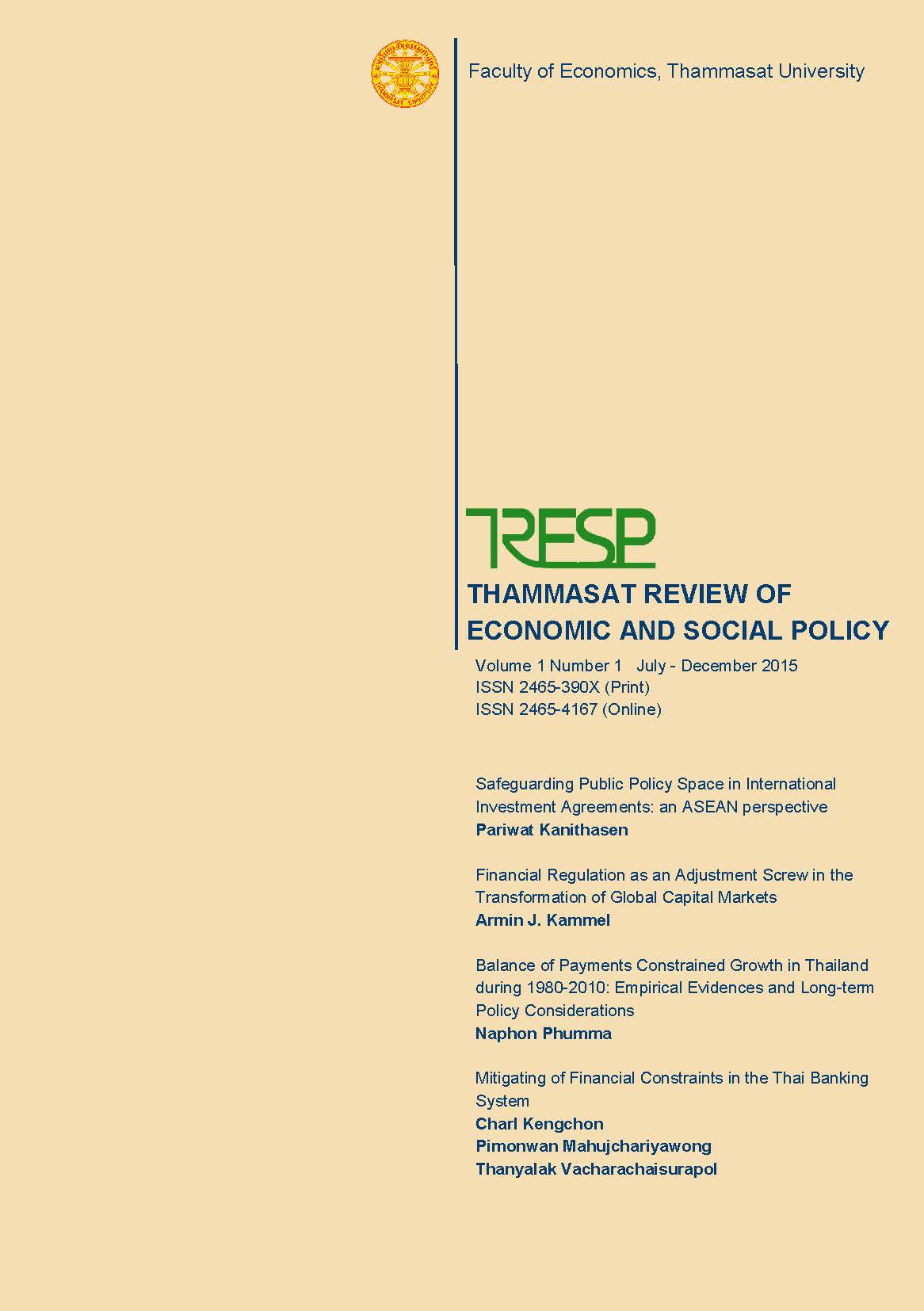Financial Regulation as an Adjustment Screw in the Transformation of Global Capital Markets
DOI:
https://doi.org/10.14456/tresp.2015.2Keywords:
Global Financial Crisis, Financial Regulation, Law and EconomicsAbstract
Globalization is typically understood as a process embracing complex economic, technological, socio-cultural and political forces which leads to progressive international integration at various levels. However, this increased interaction and interconnectedness experienced some significant drawbacks due to the global financial crisis (GFC). Although theory stresses that globalization stimulates the emergence of global financial markets leading to a significant transformation of global capital markets, the GFC clearly illustrated that the way forward is a bumpy one. Moreover, the substantial regulatory responses to the GFC led to the establishment of a complex new regulatory environment in the areas of banking and securities regulation in particular. Against this background, the contribution of this article intends to analyze this multiple transformation process by providing creative and provocative considerations on how adjustment screws could serve as a role model for future financial regulation.
References
Andenas, M. & Chiu, I. H-Y. (2014). The Foundations and Future of Financial Regulation: Governance for Responsibility. Routledge.
Arestis, P. & Basu, S. (2003). Financial Globalization and Regulation, The Levy Economics Institute Working Paper No. 397.
Baker, A., Hudson, D. & Woodward, R. (Eds.) (2005). Governing Financial Globalization, Routledge.
Baldwin, R., Cave, M. & Lodge, M. (2012). Understanding Regulation – Theory, Strategy, and Practice, Second Edition, Oxford University Press.
Bhagwati, J. (2004). In Defense of Globalization. Oxford University Press.
Bhagwati, J. (1997). The Global Age: From a Sceptical South to a Fearful North, World Economy, 20, 259-83.
Brummer, C. (2011a). Soft Law and the Global Financial System. Cambridge University Press.
Brummer, C. (2011b). How International Financial Law Works (and How it Doesn’t), Georgetown Law Journal, Vol. 99, 257-327.
Buckley, R. P. (2008). International financial system: policing and regulation, Kluwer Wolters Publishing.
Buckley, R. P. & Arner, D. W. (2011). From Crisis to Crisis – The Global Financial System and Regulatory Failure, Kluwer Wolters Publishing.
Cerny, P. G. (2005). Power, markets and accountability. In A. Baker, D. Hudson and R. Woodward (Eds.), Governing Financial Globalization. Routledge.
Croucher, S. L. (2004). Globalization and Belonging: The Politics of Identity in a Changing World, Rowman & Littlefield.
Dam, K. W. (2006). The Law-Growth Nexus – The Rule of Law and Economic Development. Brookings.
Eatwell, J. & Taylor, L. (2000). Global Finance at Risk – The Case for International Regulation. The New Press.
Eichengreen, B. (2006). Global Imbalances and the Lessons of Bretton Woods (Cairoli Lectures), MIT Press.
Empson, W. (1930). Seven types of ambiguity, Chatto & Windus.
Fein, M. L. (2013). The Shadow Banking Charade, available at SSRN: http://ssrn.com/abstract=2218812.
Friedman, J. & Kraus, W. (2011). Engineering the Financial Crisis: Systemic Risk and the Failure of Regulation. University of Pennsylvania Press.
Friedman, T. L. (2005). The World is Fla. Farrar, Straus and Giroux.
Greenspan, A. (2013). The Map and the Territory 2.0: Risk, Human Nature, and the Future of Forecasting. Penguin Books.
Hoerkman, B. M. & Kostecki, M. M. (2009). The Political Economy of the World Trading System –The WTO and beyond. Third Edition, Oxford University Press.
Imansyah, M. H. & Kammel, A. J. (2009). Forecasting Financial Crises by Applying the “Temple Model of Financial Crises” Against the Background of the Indonesian Experience, Economics and Finance in Indonesia, Vol. 57 (3), 277-306.
Isard, P. (2005). Globalization and the International Financial System. Cambridge University Press.
Kammel, A. J. (2015) Government Versus Markets- A Change in Financial Regulation. In F. Weiss and A. J. Kammel (Eds.), The Changing Landscape of the Global Financial Governance and the Role of Soft Law. BRILL Nijhoff Publishing.
Kaplan, K. J. (1972). On the ambivalence-indifference problem in attitude theory and measurement: A suggested modification of the semantic differential technique, Psychological Bulletin 77:361-372.
Kenen, P. (Eds.) (1994). Managing the World Economy: Fifty Years after Bretton Woods. Institute for International Economics.
Khan, A. (2000). The Finance and Growth Nexus, Business Review of the Federal Reserve Bank of Philadelphia, no. 1, 3-14.
King, R. & Levine, R. (1993): Finance and Growth: Schumpeter Might be Right, Quarterly Journal of Economics 108, 717-37.
Mishkin, F. (2006). The Next Great Globalization. Princeton University Press.
Niemeyer, J. (2001). An Economic Analysis of Securities Market Regulation and Supervision: Where to Go after the Lamfalussy Report? SSE/EFI Working Paper Series in Economics and Finance, No 482.
Norton, J. J. & Yokoi-Arai, M. (2001). Discerning Future Financial Crises: The Law and Institutional Based Dimensions. Bank of Valletta Review, No. 24, pp. 20- 49.
Obstfeld, M. & Taylor, A. (2004). Global Capital Markets: Integration, Crisis and Growth. Cambridge University Press.
Pauly, L. W. (2009). The Old and The New Politics of International Financial Stability, Journal of Common Market Studies, 47, 955-975.
Reinhart, C. M. & Rogoff, K. (2011). This Time Is Different: Eight Centuries of Financial Folly. Princeton University Press.
Schinasi, G. J. (2005). Safeguarding Financial Stability: Theory and Practice, IMF.
Schneiderman, D. (2013). Resisting Economic Globalization – Critical Theory and International Investment Law. Palgrave.
Shiller, R. J. (2008). The Subprime Solution: How Today’s Global Financial Crisis Happened, and What to Do About it. Princeton University Press.
Shiller, R. J. (2000). Irrational Exuberance. First Broadway Books.
Stiglitz, J. E. (2003). Globalization and its Discontents. W.W. Norton.
Tamanaha, B. Z. (2004). On the Rule of Law – History, Politics, Theory. Cambridge University Press.
Tanzi, V. (2011). Government versus Markets – The Changing Economic Role of the State. Cambridge University Press.
Tornell, A., Westermann, F. & Martinez, L. (2003). Liberalization, Growth and Financial Crises – Lessons from Mexico and the Developing World, UCLA Economics Online Papers, No. 276.
Mises, L. V. (1998). Human Action, The Scholar’s Edition, Ludwig Von Mises Institute.
Wapshott, N. (2011). Keynes-Hayek, The Clash that Defined Modern Economics. W.W. Norton & Company.
Weiss, F. & Kammel, A. J. (Eds) (2015). The Changing Landscape of the Global Financial Governance and the Role of Soft Law. BRILL Nijhoff Publishing.
Wymeersch, E., Hopt, K. & Ferrarini, G. (Eds) (2012). Financial Regulation and Supervision. Oxford University Press.



